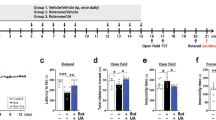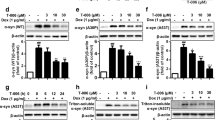Abstract
Dysfunction of the proteasome function is known to be a potential mechanism for dopaminergic neuron degeneration. Here, we investigated to determine whether systematic administration of proteasome inhibitor, carbobenzoxy-l-γ-t-butyl-l-glutamyl-l-alanyl-l-leucinal (PSI), causes the increased susceptibility in 1-methyl-4-phenyl-1,2,3,6-tetrahydropyridine (MPTP)-treated mice. PSI was injected into MPTP-treated mice over a period of 2 weeks. Thereafter, we evaluated the effect of PSI 2, 4, and 8 weeks after the cessation of treatment with PSI. In the present study with HPLC analysis, PSI did not enhance MPTP-induced dopaminergic neurotoxicity in mice. Our present study with Western blot analysis also demonstrated that the reduction of tyrosine hydroxylase (TH) and glial fibrillary acidic protein (GFAP) protein levels in MPTP-treated mice was more pronounced than that in MPTP + PSI-treated animals. These results suggest that proteasome inhibitor did not enhance MPTP neurotoxicity in mice. Our findings suggest that proteasome inhibition is not a reliable model for PD. Thus, our findings provide further valuable information for the pathogenesis of Parkinson’s disease.



Similar content being viewed by others
References
Araki T, Kumagai T, Tanaka K, Matsubara M, Kato H, Itoyama Y, Imai Y (2001) Neuroprotective effect of riluzole in MPTP-treated mice. Brain Res 918:176–181
Bove J, Zhou C, Jackson-Lewis V, Taylor J, Chu Y, Rideout HJ, Wu DC, Kordower JH, Petrucelli L, Przedbroski S (2006) Proteasome inhibition and Parkinson’s disease modeling. Ann Neurol 60:260–264
Braak H, Del Tredici K, Rub U, de Vos RA, Jansen Steur EN, Braak E (2003) Staging of brain pathology related to sporadic Parkinson’s disease. Neurobiol Aging 24:197–211
Burns RS, Chiueh CC, Markey SP, Ebert MH, Jacobowitz DM, Kopin IJ (1983) A primate model of parkinsonism: selective destruction of dopaminergic neurons in the pars compacta of the substantia nigra by N-methyl-4-phenyl-1,2,3,6-tetrahydropyridine. Proc Natl Acad Sci USA 80:4546–4550
Camacho-Arroyo I, Villamar-Cruz O, Gonzalez-Arenas A, Guerra-Araiza C (2002) Participation of the 26S proteasome in the regulation of progesterone concentrations in the rat brain. Neuroendocrinology 76:267–271
Cross T (1981) Aquatic actinomycetes: a critical survey of the occurrence, growth and role of actinomycetes in aquatic habitats. J Appl Bacteriol 50:397–423
Dauer W, Przedborski S (2003) Parkinson’s disease: mechanisms and models. Neuron 39:889–909
Dringen R, Gutterer JM, Hirrlinger J (2000) Gultathione metabolism in brain. Metabolic interaction between astrocytes and neurons in the defense against reactive oxygen species. Eur J Biochem 267:4912–4916
Ensign JC, Normand P, Burden JP, Yallop CA (1993) Physiology of some actinomycete genera. Res Microbiol 144:657–660
Fenteany G, Schreiber SL (1998) Latacystin, proteasome function, and cell fate. J Biol Chem 273:8545–8548
Fornai F, Lenzi P, Gesi M, Ferrucci M, Lazzeri G, Busceti CL, Ruffoli R, Soldani P, Ruggieri S, Alessandri MG, Paparelli A (2003) Fine structure and biochemical mechanisms underlying nigrostriatal inclusions and cell death after proteasome inhibition. J Neurosci 23:8955–8966
Gallo F, Morale MC, Spaima-Purrello V, Tirolo C, Testa N, Farinella Z, Avola R, Beaudet A, Marchetti B (2000) Basic fibroblast growth factor (bFGF) acts on both neurons and glia to mediate the neurotrophic effects of astrocytes on LHRH neurons in culture. Synapse 36:233–253
Heikkila RE, Hess A, Duvoisin RC (1984) Dopaminergic neurotoxicity of 1-methyl-4-phenyl-1,2,5,6-tetrahydropyidine in mice. Science 224:1451–1453
Hirst SJ, Ferger B (2008) Systemic proteasomal inhibitor exposure enhances dopamine turnover and decreases dopamine levels but does not affect MPTP-induced striatal dopamine depletion in mice. Synapse 62:85–90
Jana NR, Dikshit P, Goswami A, Nukina N (2004) Inhibition of poteasomal function by curcumin induces apoptosis through mitochondrial pathway. J Biol Chem 279:11680–11685
Jenner P (2003) Oxidative stress in Parkinson’s disease. Ann Neurol 53:S26–S38
Kazi A, Urbizu DA, Kuhn DJ, Acebo AL, Jackson ER, Greenfelder GP, Kumar NB, Dou QP (2003) A natural musaceas plant extract inhibits proteasome activity and induces apotosis selectively in human tumor and transformed, but not normal and non-transformed, cells. Int J Mol Med 12:879–887
Kisselev AF, Goldberg AL (2001) Proteasome inhibitiors: from research tools to drug candidates. Chem Biol 8:739–758
Kitada T, Asakawa S, Hattori N, Matsumine H, Yamamura Y, Minoshima S, Yokochi M, Mizuno Y, Shimizu N (1998) Mutations in the parkin gene cause autosomal recessive juvenile parkinsonism. Nature 392:605–608
Koguchi Y, Kohno J, Nishio M, Takahashi K, Okuda T, Ohnuki T, Komatsubara S (2000) TMC-95A, B, C, and D, novel proteasome inhibitors produced by Apiospora montagnei Sacc. TC 1093. Taxonomy, production, isolation, and biological activities. J Antibiot 53:105–109
Kordower JH, Kanaan NM, Chu Y, Babu RS, Stansell J, Terpstra BT, Sortwell CE, Strece-Collier K, Collier TJ (2006) Failure of proteasome inhibitor administration to provide a model of Parkinson’s disease in rats and monkeys. Ann Neurol 60: 264–268
Kurosaki R, Muramatsu Y, Kato H, Watanabe Y, Imai Y, Itoyama Y, Araki T (2005) Effect of angiotensin-converting enzyme inhibitor perindopril on interneurons in MPTP-treated mice. Eur Neuropsychopharmacol 15:57–67
Langston JW, Ballard P, Terud JW, Irwin I (1983) Chronic parkinsonism in humans due to a product of meperidine-analog synthesis. Science 219:979–980
McNaught KS, Belizaire R, Isacson O, Jenner P, Olanow CW (2003) Altered proteasomal function in sporadic Parkinson’s disease. Exp Neurol 179:38–46
McNaught KS, Perl DP, Brownell AL, Olanow CW (2004) Systemic exposure to proteasome inhibitors causes a progressive model of Parkinson’s disease. Ann Neurol 56:149–162
Miwa H, Kubo T, Suzuki A, Nishi K, Kondo T (2005) Retrograde dopaminergic neuron degeneration following intrastriatal proteasome inhibition. Neurosci Lett 380:93–98
Morale MC, Serra PA, L’episcopo F, Tirolo C, Caniglia S, Testa N, Gennuso F, Giaquinta G, Rocchitta G, Desole MS, Miele E, Marchetti B (2006) Estrogen, neuroinflammation and neuroprotection in Parkinson’s disease: glia dictates resistance versus vulnerability to neurodegeneration. Neuroscience 138:869–878
Muramatsu Y, Kurosaki R, Watanabe H, Michimata M, Matsubara M, Imai Y, Araki T (2003) Expression of S100 protein is related to neuronal damage in MPTP-treated mice. Glia 42:307–313
Nam S, Smith DM, Dou QP (2001) Ester bond-containing tea polyphenols potently inhibit proteasome activity in vitro and in vivo. J Biol Chem 276:13322–13330
Nawashiro H, Brenner M, Fukui S, Shimada K, Hallenbeck JM (2000) High susceptibility to cerebral ischemia in GFAP-null mice. J Cereb Blood Flow Metab 20:1040–1044
Olanov CW, Schapira AH, Agid Y (2003) Neuroprotection of Parkinson’s disease: Prospects and promises. Ann Neurol 53(Suppl 3):S1–S2
Petrucelli L, Dawson TM (2004) Mechanism of neurodegenerative disease: role of the ubiquitin proteasome system. Ann Med 36:315–320
Phillips JB, Williams AJ, Adams J, Elliott PJ, Tortella FC (2000) Proteasome inhibitor PS519 reduces infarction and attenuates leukocyte infiltration in rat model of focal cerebral ischemia. Stroke 31:1686–1693
Priyadarshi A, Khuder SA, Schaub EA, Priyadarshi SS (2001) Environmental risk factors and Parkinson’s disease: a metaanalysis. Environ Res 86:122–127
Schapira AH, Cletter MW, Muddle JR, Workman JM, Cooper JM, King RH (2006) Proteasomal inhibition causes loss of nigral tyrosine hydroxylase neurons. Ann Neurol 60:253–255
Sherman NY, Goldberg AL (2001) Cellular defenses against unfolded proteins: a cell biologist thinks about neurodegenerative diseases. Neuron 29:15–32
Sin N, Kim KB, Elofsson M, Meng L, Auth H, Kwok BH, Crews CM (1999) Total synthesis of the potent proteasome inhibitor epoxomicin: a useful tool for understanding proteasome biology. Bioorg Med Chem Lett 9:2283–2288
van Leyen K, Siddiq A, Ratan RR, Lo EH (2005) Proteasome inhibition protects HT22 neuronal cells from oxidative glutamate toxicity. J Neurochem 92:824–830
Yamamoto N, Sawada H, Izumi Y, Kume T, Katsuki H, Shimohama S, Akaike A (2007) Proteasome inhibition induces glutathione synthesis and protects cells from oxidative stress. J Biol Chem 282:4364–4372
Zhang Y, Gao J, Chung KK, Huang H, Dawson VL, Dawson TM (2000) Parkin functions as an E2-dependent ubiquitin-protein ligase and promotes the degradation of the synaptic vesicle-associated protein, CDCrel-1. Proc Natl Acad Sci USA 97:13354–13359
Acknowledgments
This study was supported in part by Grant-in-Aid for Scientific Research (136700627 and 13671095) from the Ministry of Science and Education in Japan.
Author information
Authors and Affiliations
Corresponding author
Additional information
Naoto Kadoguchi and Masahiro Umeda contributed equally to this work.
Rights and permissions
About this article
Cite this article
Kadoguchi, N., Umeda, M., Kato, H. et al. Proteasome Inhibitor Does Not Enhance MPTP Neurotoxicity in Mice. Cell Mol Neurobiol 28, 971–979 (2008). https://doi.org/10.1007/s10571-008-9271-4
Received:
Accepted:
Published:
Issue Date:
DOI: https://doi.org/10.1007/s10571-008-9271-4




